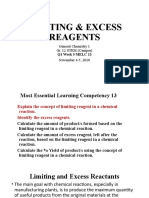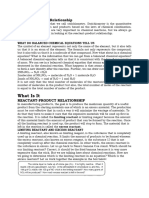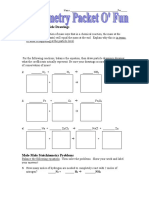Limiting Reactants
Uploaded by
api-483662721Limiting Reactants
Uploaded by
api-483662721Name _______________________________Per________
In a reaction, the reactant that gets used up first is called the “limiting reactant”. If you are given more
than one amount to begin with in a problem, it is important to determine which is the limiting reactant
before solving the problem. To do that, you need to use stoichiometry on each reactant to see which
one will produce less product. That’s the reactant that will be used up first.
Determine the limiting reactant in each of the following problems. Balance the equation first!
1. Identify the limiting reactant if 4.1g of Cr is heated with 9.3g of Cl2 to produce CrCl3. What mass
of CrCl3 will be produced?
2. Identify the limiting reactant when 1.22 mol of O2 reacts with 1.05 mol of H2 to produce water.
How many moles of water will be produced?
3. Identify the limiting reactant when 43.25g of CaC2 reacts with 33.71g of water to produce Ca(OH)2
and C2H2. How many grams of C2H2 will be produced?
4. Identify the limiting reactants when 4.687g of SF4 reacts with 6.281g of I2O5 to produce IF5 and
SO2. How many liters of SO2 gas will be produced (assume the gas is at STP).
5. Identify the limiting reactant when 12.84g of HCl reacts with 5.87g of Mg(OH)2 to form MgCl2
and water. How many molecules of water will be produced?
You might also like
- Limiting Reagents Percent Yield WorksheetNo ratings yetLimiting Reagents Percent Yield Worksheet7 pages
- 4th Periodical Test Chemistry 1 2017 2018 (Mid Term)No ratings yet4th Periodical Test Chemistry 1 2017 2018 (Mid Term)15 pages
- 03 ABM 12 PASAY Physical Science S2 Q1 W6No ratings yet03 ABM 12 PASAY Physical Science S2 Q1 W620 pages
- Worksheet - Limiting and Excess Problems - Vu100% (1)Worksheet - Limiting and Excess Problems - Vu2 pages
- General Chemistry 1: Quarter 1 - Module 13: Limiting and Excess ReagentsNo ratings yetGeneral Chemistry 1: Quarter 1 - Module 13: Limiting and Excess Reagents9 pages
- (4 PTS) A Student Makes Aspirin in Lab. She Reports That She Has Produced 2.43 G. If TheNo ratings yet(4 PTS) A Student Makes Aspirin in Lab. She Reports That She Has Produced 2.43 G. If The2 pages
- 6uu6izgr2 - MODULE 6 STOICHIOMETRY PART IIINo ratings yet6uu6izgr2 - MODULE 6 STOICHIOMETRY PART III3 pages
- Limiting Reactant and Stoichiometry Notes and PracticeNo ratings yetLimiting Reactant and Stoichiometry Notes and Practice8 pages
- Reactivity 2.1 - How Much-The Amount of Chemical ChangeNo ratings yetReactivity 2.1 - How Much-The Amount of Chemical Change34 pages
- WK 5 MELC 13 Limiting & Excess ReagentsNo ratings yetWK 5 MELC 13 Limiting & Excess Reagents22 pages
- Stoichiometry Assignment 3 Mass-Volume Problems #1 - 10 NameNo ratings yetStoichiometry Assignment 3 Mass-Volume Problems #1 - 10 Name21 pages
- Q1 M8 SHS - General-Chemistry-1 - Limiting-ReagentNo ratings yetQ1 M8 SHS - General-Chemistry-1 - Limiting-Reagent18 pages
- Physical Science: Quarter 1 - Module 10: Limiting Reactants and The Amount of Products Formed100% (1)Physical Science: Quarter 1 - Module 10: Limiting Reactants and The Amount of Products Formed22 pages
- Reaction Stoichiometry CHEM 10 Review WorksheetNo ratings yetReaction Stoichiometry CHEM 10 Review Worksheet3 pages
- Answer The Following Questions For Chemistry ReviewNo ratings yetAnswer The Following Questions For Chemistry Review6 pages
- 3. Limiting Reactants and Percent YieldNo ratings yet3. Limiting Reactants and Percent Yield20 pages
- Chapter 9 - Balancing Equations: Change!!!! (Don't Change The Subscripts!)No ratings yetChapter 9 - Balancing Equations: Change!!!! (Don't Change The Subscripts!)2 pages




















































































